Uncategorized
A new portrait collection showcases 90 Holocaust survivors who lived long and full lives
(JTA) — Werner Reich had his opening line ready when he sat down for B.A. Van Sise to take his portrait.
“Before I could say anything, he said, ‘Everybody comes to me and they want me to talk about the Holocaust. What am I supposed to say? I went to Auschwitz. It was lousy,’” Van Sise said, recalling that Reich’s comment felt like a joke, not a lament.
But instead of dwelling on the horrors of the Nazi concentration camp, the two men spoke about magic, a refuge for Reich as a Jewish teenager trying to survive. The resulting portrait shows a man in his 90s wearing retro glasses, a cloud of smoke floating a few inches above his open palm, in a picture vibrating with life and with enchantment.
Van Sise’s portrait of Reich is the first in “Invited to Life: Finding Hope After the Holocaust,” his new portrait collection of 90 Holocaust survivors. The accompanying text acknowledges Reich’s experience at Auschwitz, but it focuses more on Reich’s life after the war and his long career in magic — striking a balance that Van Sise says is core to his project.
“This is not something that people are inclined to talk about because it’s not always bombastic. It’s not the part that you sell movie tickets to,” Van Sise said. “You can make, and people have, a hundred movies about Jewish people being imprisoned, tortured, and enslaved. Why doesn’t anybody talk about them thriving afterwards?”
Holocaust survivor and hiking enthusiast Sam Silberberg poses for “Invited to Life”. (Courtesy of B.A. Van Sise / Design by Grace Yagel)
Van Sise is far from the first photographer to capture the faces of survivors in the decades following the end of the Second World War. Famed portrait photographers Martin Schoeller and Mark Seliger, both known for their iconic celebrity portraiture — Schoeller for his uniform, stylized close-ups and Seliger as a magazine photographer who also recently photographed Jerry Seinfeld in a fashion shoot — have also set their cameras in front of Holocaust survivors. Countless other photographers have done the same. But what Van Sise says is sometimes missing from survivor photography is a focus on the postwar lives, many of them joyous, that the subjects have experienced over the last 70-plus years.
“I suspect that one person might see these folks and see victims,” Van Sise said. “And I see them as survivors.”
Holocaust survivor and Park East Synagogue Rabbi Arthur Schneier poses for “Invited to Life”. (Courtesy of B.A. Van Sise / Design by Grace Yagel)
“Invited to Life” was inspired by a 2015 photo assignment Van Sise took on for the Village Voice. Motivated by the anti-immigrant, anti-refugee rhetoric of then-candidate for president Donald Trump, he realized that a particularly cohesive cohort of refugees to come to the United States had arrived more than 75 years ago, at the end of the Second World War, and a photographic retrospective on their lives in America could be a valuable project. He reached out to the Museum of Jewish Heritage in New York to be put in touch with a dozen survivors for the story. He ended up taking more than 30 portraits. When the alternative newsweekly ceased publication in 2017 (it was revived in 2021) before he could publish the photos, the museum invited Van Sise to turn the portraits into a solo exhibition, in what became the museum’s first-ever public art installation.
Then the pandemic arrived, and like many photographers whose everyday work required travel, Van Sise was out of a job.
“It had never been a marquee project for me,” said Van Sise, who is Jewish but has no familial connection to the Holocaust. “I kept coming back and thinking about them, and about the fact that these people had been through the worst there ever was, the worst that ever has been, the worst there ever might even be.”
Holocaust survivor and painter Fred Terna poses for “Invited to Life”. (Courtesy of B.A. Van Sise / Design by Grace Yagel)
Van Sise spent the better part of 2020 driving around the United States, getting COVID swabs every three days so he could safely photograph 140 elderly survivors, 90 of whom ended up in the book. (He was insistent with his publisher that the final number of portraits in the book be a multiple of 18, the Jewish numerical symbol for “life”.)
The photos are all in black and white, but beyond that, they are as diverse as Sise’s subjects. Some incorporate backgrounds, some are solo portraits; some are serious, some are silly; some include children, grandchildren, husbands, wives, props; some are in profile, and some are shot straight on. The subjects are Nobel Prize-winning chemists and homemakers; pilots and psychologists; haberdashers and teachers; famed rabbis and partisans-turned-conmen.
All of them, Sise says, were photographed with a sense of generosity.
“A person who wants to be critical of me — which is fair — might say that I’m overly charitable,” Van Sise says of his own work, acknowledging that no photographer can avoid bias completely while behind the camera. (It didn’t help that many of the survivors he photographed were eager to feed him cookies, as he frequently recalls.)
In the nearly three years since Van Sise began photographing the subjects of his book, the reality of working with more than 100 elderly people set in. Several of the survivors, including Holocaust educator René Slotkin, Budapest-born legal secretary Kathy Griesz and Reich died before they got the chance to hold a copy of the book in their hands, much to Van Sise’s dismay.
“As a writer, you carry them with you,” he said. “So for me, there were a few where I got pretty rattled.”
Holocaust survivor and educator René Slotkin poses for “Invited to Life”. (Courtesy of B.A. Van Sise / Design by Grace Yagel)
The photographs reflect acknowledgment by all involved that the survivors in the pictures are all nearing the ends of their lives. Many of his subjects chose to include their children, grandchildren, or great-grandchildren in their portraits, and the photographer was intentional in closing the book with a portrait of Irving Roth, a longtime Holocaust educator, with his 3-year-old great-granddaughter Addie sitting on his lap. In the text, Roth remarks on the origins of his Hebrew name, Shmuel Meir, which came from his great-grandfather and imagines what life will be like for Addie when she turns 103, and what she will remember of him.
Roth passed away in February 2021 at age 91.
“Those stories don’t end in 1945,” Van Sise said. “These people have lived for, now, 77 years since and have done plenty with that time. And that’s worth exploring, because that’s the part they have control over.”
Reflecting on different styles of Holocaust survivor portraiture at a discussion at the Museum of Jewish Heritage, the original home of Van Sise’s portraits, German photographer Martin Schoeller remarked on his own preference for images of older faces.
Holocaust survivor and educator Irving Roth and great-granddaughter Addie pose together for “Invited to Life”. (Courtesy of B.A. Van Sise / Design by Grace Yagel)
“They have more life in them. You see the wrinkles and you feel that there’s more to discover in the face, in an old face. So they almost feel like they’re telling the story of the suffering of the Holocaust more visually, because they’re older faces,” Schoeller said.
“But then, it’s been 75 years since the end of the war,” he added. “So these people have lived 75 years; so to say, ‘Now I see the horror in this old man’s face’ feels a little bit — I don’t know if that’s really true. I leave it up to the people looking at the pictures.”
—
The post A new portrait collection showcases 90 Holocaust survivors who lived long and full lives appeared first on Jewish Telegraphic Agency.
Uncategorized
The Iranian People Are Demanding Their Freedom; Where Is the Media?

Protesters demonstrate against poor economic conditions in Tehran, Iran, with some shopkeepers closing their stores on Dec. 29, 2025, in response to ongoing hardships and fluctuations in the national currency. Photo: ZUMA Press Wire via Reuters Connect
“What were the media doing when the regime led by Ali Khamenei finally fell?”
That is the question that will be asked if, as many Iranians now dare to hope, we are witnessing the final days of the Islamic Republic after more than four decades in power. It is also a question the Western press may struggle to answer.
How It Started
The current wave of unrest began in late December, when shopkeepers in Tehran went on strike amid growing fury over Iran’s collapsing economy. The rial hit record lows, while prices continued to soar under crippling inflation. Traders, wholesalers, and merchants took to the streets in protest, initially over economic mismanagement — but anger quickly turned toward the regime itself.
Within 48 hours, demonstrations had spread beyond the capital to major cities including Isfahan, Shiraz, Mashhad, Hamadan, Qeshm, and beyond. Videos posted by Iranians showed crowds chanting explicitly political slogans: “Death to the dictator,” “Mullahs must go,” and “This homeland will not be free until the mullah is gone.”
Iranian state-affiliated media have acknowledged several deaths. Independent estimates suggest the toll may be significantly higher. What is not in dispute is that the unrest has rapidly evolved from economic protest into a broad-based challenge to clerical rule.
The Story the Media Barely Told
And yet, on Friday, The New York Times ran not a single front-page story on the protests.
Not one.
This was unrest that — if it succeeds — could reshape Iran, the Middle East, and global security dynamics for decades. A regime that backs Hamas and Hezbollah, arms terrorist proxies across the region, threatens Israel’s destruction, and destabilizes international energy markets was facing its most sustained nationwide dissent in years. Still, the story barely registered.
The New York Times’ near silence was not an outlier. It was emblematic.
When the lack of coverage was challenged on social media, John Simpson, World Affairs Editor at the BBC, offered an almost comical defense: social media videos, he said, must be carefully verified before “reputable outlets” can use them.
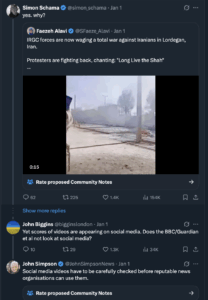
That principle, in isolation, is uncontroversial. But its selective application is not.
This is the same BBC that has repeatedly broadcast unverified — or lightly verified — footage and photographs from Gaza. In Iran, however, verification suddenly became an insurmountable obstacle, even as dozens of videos from multiple cities showed consistent scenes, slogans, and patterns of unrest.
When Framing Does the Regime’s Work
Reports by the BBC and analyses from BBC Verify have repeatedly emphasized “cost-of-living protests,” despite verified footage of crowds chanting for the end of clerical rule and attacking regime symbols.
Where BBC Verify has undertaken the “verification” John Simpson said was so difficult, it has drawn criticism for focusing on debunking isolated instances of AI-generated imagery — rather than acknowledging the overwhelming volume of genuine footage documenting brutality against protesters.
Genuinely shocked to see BBC Verify have chosen now to be out there giving an impression we should not believe what we are seeing in #Iran based on one image (of a real event).
Amplification of this intensely organic revolution by Israeli social media accounts is making many…
— Omid Djalili (@omid9) January 2, 2026
Sky News, Reuters, FRANCE24, and others followed a similar pattern — leading with rising prices and economic stagnation while giving little attention to the unmistakably political slogans echoing through Iranian streets.
This framing matters. Protests about inflation suggest reform. Protests calling for the removal of the Supreme Leader suggest regime collapse.
In some cases, Western coverage has gone further, adopting the regime’s preferred framing outright.
When President Donald Trump warned that the United States would respond if Iranian protesters were massacred, Iranian officials condemned the remarks as “reckless.” Several outlets, including the BBC, led with that condemnation, centering Tehran’s outrage and implicitly casting the United States, rather than the Islamic Republic, as the destabilizing force.
Last week, The Guardian even published an opinion piece by Iran’s foreign minister, Abbas Araghchi, under the headline: “You’ll never defeat us in Iran, President Trump: but with real talks, we can both win.”
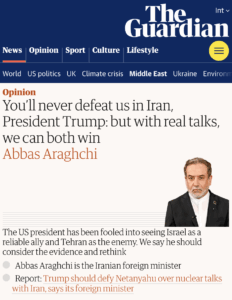
Put simply, this was The Guardian lending its pages to the propaganda of a senior official from the very regime Iranians are risking their lives to oppose — the same Islamic Republic that beat Mahsa Amini to death for allegedly wearing her hijab incorrectly, executed protesters, imprisoned dissidents, and ruled through fear for 45 years.
1/
Western media coverage of Iran’s escalating nationwide protests has been strikingly limited and cautious – despite widespread anti-regime demands across dozens of cities.Why the reluctance, when evidence is abundant?
pic.twitter.com/PWF9hgsdI3
— HonestReporting (@HonestReporting) January 3, 2026
So Why Is the Media Reporting This Way?
Western journalists do not lack information about Iran. The evidence is abundant and often supplied at immense personal risk by Iranians themselves.
What appears lacking is not access, but editorial willingness.
Acknowledging an evolving anti-regime uprising would force uncomfortable conclusions: that long-standing assumptions about “stability,” “reform,” and diplomatic engagement with Tehran were misplaced; that the Islamic Republic is not merely flawed but fundamentally illegitimate; and that Western governments and institutions have spent decades accommodating a brutal regime now being openly rejected by its own people.
It is easier — safer — to frame unrest as economic grievance, to hide behind verification rhetoric, or to platform regime voices as “context.”
But if this uprising succeeds, history will not be kind to that caution. And the question will remain: When Iranians were demanding freedom, why did so much of the Western media look away?
The author is a contributor to HonestReporting, a Jerusalem-based media watchdog with a focus on antisemitism and anti-Israel bias — where a version of this article first appeared.
Uncategorized
Palestinian Authority Police Commit Another Terrorist Attack
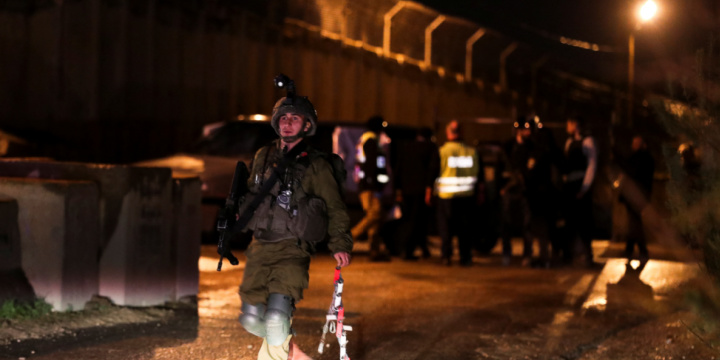
Illustrative: Israeli forces gather at the scene of a shooting attack near a Jewish outpost, near Nablus, in the West Bank, December 16, 2021. REUTERS/Ammar Awad
When Palestinian Authority (PA) police officer and Fatah’s Al-Aqsa Martyrs’ Brigades terror-wing member Younes Walid Shtayyeh shot at Israeli special forces and wounded an Israeli soldier near Nablus, it was not cause for self-scrutiny on behalf of the PA police.
On the contrary, two days later, PA Police Commissioner Allam Al-Saqqa elaborated on the “professional police establishment, which acts as a law enforcement body.” He stressed that the PA police force “maintains security, public order, and morality,” a message the official PA TV reporter summarized by claiming the PA police are “loyal … to the law:”
PA Police Commissioner Allam Al-Saqqa: “[Our progress] emphasizes the integrative relationship between the State Prosecutor’s Office and the [PA] Police, through participation in enforcing justice in the criminal field, which is being protected by a skilled State Prosecutor’s Office that is striving to strengthen the rule of law, alongside a professional police establishment, which acts as a law enforcement body, operates in coordination with the State Prosecutor’s Office and under its supervision, maintains security, public order and morality, and fulfills its role within the framework of the law” … [emphasis added]
[Official PA TV News, Nov. 22, 2025]
According to PA ideology, there really is no contradiction between trying to murder Israelis and maintaining the law. Fatah and Hamas alike glorified the “operation” of police terrorist Shtayyeh, and after he was killed by Israeli forces, social media overflowed with praise for him.
Palestinian Media Watch has documented the double role of the PA police and Security Forces as cops by day — and terrorists by night — many times, recently in the report, Terrorists in Uniform.
Fatah’s terror wing announced with “pride and glory” that Shtayyeh’s funeral was a “wedding” and stressed that the PA police officer died while “fulfilling the duty of struggle and engaging in armed confrontation with enemy.”
The Al-Aqsa Martyrs’ Brigades also used the opportunity to pledge to continue “the path of struggle” until “the removal” of the State of Israel:
Posted text: “A military statement by the Al-Aqsa Martyrs’ Brigades
…
Martyr fighter Younes Walid Shtayyeh — one of the fighters of the Al-Aqsa [Martyrs’] Brigades — Nablus
Who ascended to Heaven as a Martyr on Friday, Nov. 21, 2025 … while he was fulfilling the duty of struggle and engaging in armed confrontation with enemy …
The Al-Aqsa Martyrs’ Brigades, while accompanying the Martyr commander to the wedding, pledge before Allah that their fighters will continue … on the path of struggle and resistance, until the removal of the occupation from our land and our occupied holy sites.This is a revolution until victory!
The Al-Aqsa Martyrs’ Brigades – Palestine
The military wing of the Fatah Movement
Saturday… Nov. 22, 2025″ [emphasis added][Al-Aqsa Martyrs’ Brigades, Telegram channel, Nov. 22, 2025]
Fatah political officials paid condolence visits to the family, while Fatah’s terror wing described the police terrorist as a “heroic Martyr”:
Posted text: “Fatah Movement Nablus District Secretary Muhammad Hamdan ‘Abu Al-Mutaz’ and members of the district committee in a visit of blessing and condolences on the ascent to Heaven of heroic Martyr Younes Walid Shtayyeh.” [emphasis added]

The terrorist’s father praised his death as a “Martyr,” saying it was “anticipated” and that Allah “chose him”:
Father of terrorist Younes Walid Shtayyeh: “Younes… there is no one who doesn’t love him… May Allah have mercy on him [and] be pleased with him … He asked for [Martyrdom] and achieved it.
We anticipated this … We consider him a Martyr with Allah. .. The [Israeli] army’s special forces besieged the area … He took his weapon and went out, he fought them outside and fell as a Martyr … All this is the decree of Almighty Allah. Our Lord chose him [to be a Martyr].” [emphasis added]
[“Nablus News,” Telegram channel, Nov. 22, 2025]
A Hamas-affiliated network honored the terrorist, sharing a video of him posing with and firing an assault rifle, while a song played in the background:
Song lyrics: “Do not mourn, for eternal life awaits us
Shed no tears, for Paradise is the appointed meeting place
I sacrifice myself to meet Allah, for the sake of life [in Paradise] and [Allah’s] satisfaction”Posted text: “Images of [PA] police officer Martyr Younes Shtayyeh, the one who carried out the shooting operation on the occupation soldiers while they were making arrests in Nablus a few days ago. [An operation] in which he ascended to Heaven while confronting an Israeli Yamam force.” [emphasis added]
[Quds News Network (Hamas), Telegram channel, Nov. 22, 2025]
The “Al-Quds Brigades – Grandchildren of Glory,” Islamic Jihad’s terror wing, posted pictures of the terrorist, pointing out he was a police officer:

Posted text: “[PA] police officer Martyr Younes Walid Shtayyeh, whom the occupation (i.e., Israel) accuses of shooting at its forces during the raid on Nablus yesterday”
[“Al-Quds Brigades – Grandchildren of Glory,” Telegram channel, Nov. 21, 2025]
Other groups applauded terrorist Shtayyeh as a “Jihad fighter” and stressed that he was “a son of the Fatah Movement. A son of the Palestinian Security Forces”:

The author is a contributor to Palestinian Media Watch, where a version of this story first appeared.
Uncategorized
An idyllic Jewish village, full of life and hope, just hours before its utter annihilation
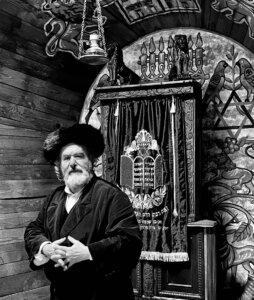
A remarkable scene in Ady Walter’s film Shttl takes place in a Jewish Ukrainian village outside of Kiev on June 21, 1941, one day before the Nazi invasion, known as Operation Barbarossa.
The Rebbe, played by the always excellent Saul Rubinek is the voice of reason; he is a thoughtful, complex, contradictory and conflicted character. He does not raise his voice, he takes time to consider what to say as he himself struggles to respond to whatever factionalism arises within the community. His sad eyes are expressive. He repeatedly rubs his thumb across his fingers. This is a master class in consummate acting.
The mostly black-and-white Yiddish language film, currently playing in New York at New Plaza Cinemas, spans 24 hours in the shtetl, whose residents remain clueless of the impending doom despite the presence of the Russian Army that has already infiltrated the village. Nonetheless the cracks are surfacing within the community. Intense arguments abound on such issues as workers rights and whether to abandon religion or commit to a devoted life. One female character espousing the need for women’s rights, anticipates the future struggle of feminism in the face of patriarchy.
At its core, the film explores Jewish identity, unity and survival. The Rebbe understands factionalism yet remains implacable as he urges the townspeople to be Talmudic in their judgments, tolerant and compassionate. He describes true Jewishness as the color gray, allowing for and even respecting differences of opinion, purpose and worldview.
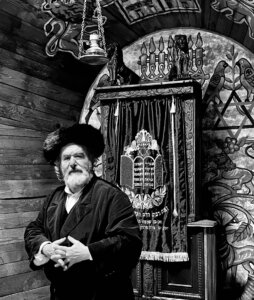
For, the Rebbe, Jews must always remain unified on some profound level. “Unity is the only thing that matters in the battle against evil,” he asserts. His second tenet is faith in God. Doubt can never enter the picture.
The central character, Mendele (Moshe Lobel in a nicely understated performance) is an aspiring filmmaker, who has long since left the shtetl to join the Red Army in Kyiv. But he returns home along with his best friend, a non-Jewish Ukrainian named Demyan (Petro Ninovskyi), so he can elope with his true love, Yuna (Anisia Stasevich), the child of The Rebbe.
But Yuna is already engaged through an arranged marriage to Folie (Antoine Millet), a cruel, autocratic Hasid who, despite his alleged religiosity, is petty, sly, cunning and ultimately violent.
Mendele remains torn between his ambitions embodied by the cosmopolitan outside world and the restrictive, confined shtetl where he is still deeply rooted. And he can’t help but feel connected to his estranged father, whom he holds responsible for the suicide of his late mother who, like Mendele, was also an outlier.
The film was shot in Ukraine in 2021 at the height of COVID-19 restrictions and at the very moment the Russian invasion was looming. The set, including a synagogue, was supposed to be converted into a museum honoring Ukraine’s Jewish past. But in the end, the Russian forces destroyed the whole shtetl set and the land was mined. Now that the president of Ukraine is a Jew at the very same time antisemitism is surging across the globe and Ukrainians and Jews are both under assault, the parallels and irony are almost implausible.
Walter, a documentary film director making his feature debut, has said his mission was to bring the shtetl universe that was totally wiped out during the Holocaust back to life. The title Shttl with its missing “e” references the 1969 novel, La Disparition by Georges Perec, whose mother died in Auschwitz. In Perec’s fictional work the letter “e” never appears in Shttl, its absence mirroring the emptiness, the void, the loss.
In this film, unlike such Holocaust classics like Schindler’s List, The Pianist, Son of Saul, death, despair, and hopelessness are not yet part of the collective experience. This is life prior to the Holocaust in an ethnically diverse community overflowing with purpose and hope for the future. Many Jews and gentiles enjoy camaraderie, and Yiddish and Ukrainian are both spoken.
Shtll’s cinematic technique is evocative, specifically the way scenes of recollection seamlessly morph into color — Mendele recalls his life as a yeshiva boy and the time his gentle mother gave him a baby rabbit as a pet. The colorful flashbacks suggest the past is so much more vivid than the black-and-white present.
Nevertheless, I found the film problematic. Though it has been praised for its one-shot cinematic approach, which purports to make the movie more immediate, real and immersive for the viewer, the set and the inconsistent performances made it feel more like a filmed stage play to me. And, more importantly, the characters don’t seem like actual human beings as they do spokespersons for various political, philosophical,and religious viewpoints. The quirky folkloric figures don’t help. There are two holy fools of various stripes — a beatific deceased mom who appears as a spectral figure, and my favorite, the butcher who has become a vegetarian.
Admittedly, my image of shtetl life is informed by a Fiddler on the Roof ethos and, by extension, the stories of Sholem Aleichem which presents a largely impoverished, insular and marginalized world, even if its residents don’t see themselves as disenfranchised. But in Shtll, the youthful characters are self-confident in their speech, gestures, and especially their wide-stride, swaggering gaits. They seemed jarringly secular and contemporary to me.
In one scene, our three protagonists, including Yuna, are happily passing back and forth a bottle of booze, each guzzling from the communal cap. The provincial virginal daughter of The Rebbe in a 1941 shtetl? Really?
In the end, though, the film makes a 180-degree turn that nearly eradicates its flaws. Mendele, Demyan, and Yuna have spent the night in the forest and have fallen asleep content in their certainty that at sunrise they will be embarking on their great adventure to freedom.
As dawn breaks and the sun begins to emerge over the trees. Mendele hears gunfire and spies the battalions of Nazis entering the shtetl en masse. The obliteration that will follow is clear. The respective politics, philosophies, not to mention petty jealousies, indeed, all the internecine fighting on the one hand and the moments of jubilation on the other have become totally meaningless. The realization is devastating.
The post An idyllic Jewish village, full of life and hope, just hours before its utter annihilation appeared first on The Forward.





